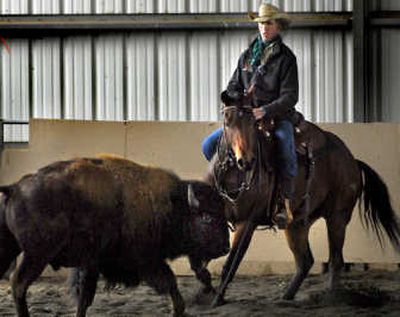‘Ya-hoo’ messenger

Small town boy from Montana,
he wore a red bandana
with a guitar always close at hand
led by his intuition, he had but one ambition
to become the greatest yodeler in the land
“Yodeling Fool,” Wylie Gustafson
Let’s do a little free association.
Think of “yodeling.” What comes to mind?
Austrian sheepherders? A guy in lederhosen? A 1950s cowboy singer with a big hat and belt buckle to match?
Now, think of country superstar LeAnn Rimes. Yep, she’s a yodeler.
And Shakira, that hip-shaking, belly-baring pop star? She yodels, too.
There’s even 12-year-old Taylor Ware, “America’s Yodeling Sweetheart,” who was a finalist on the NBC show “America’s Got Talent” last year.
So, yes, yodeling is alive, well and yodel-ay-ee-ooing from the mountaintops, thank you very much.
Take it from Wylie Gustafson. The 46-year-old rancher from the tiny Whitman County town of Dusty, Wash., started yodeling in his early teens and has never stopped, releasing a dozen albums over the past 20 years.
It’s Gustafson’s yodel that provides the now-iconic “ya-hoo-ooo” in commercials for the online search engine Yahoo.
And he recently released “How to Yodel: Lessons to Tickle Your Tonsils” (Gibbs Smith, $9.95), a light introduction to the art of yodeling, complete with instructional CD.
“It’s a vocal art form that’s very intricate and can be very pretty and very moving emotionally,” Gustafson says. “It can be very beautiful and very powerful.”
In the right hands, of course.
As Gustafson outlines in his book, the biggest trick to yodeling is finding your “voice break.” That’s where a singer’s lower register and upper register split, and the yodeler can be heard switching from normal voice to falsetto.
“Relax and have fun and don’t take yourself too seriously,” Gustafson says. “To find that voice break you need to be really relaxed. If you’re self-conscious or tight, it just doesn’t work.”
Like Gustafson, Lewiston resident Buzz Goertzen started yodeling as a child. He and his nine siblings would sing along with the record player, using a broomstick as a guitar and a spoon as a microphone.
“I found out I could yodel,” says Goertzen, now 71. “It just came out. It wasn’t something I had to practice; it was just there.”
Goertzen later gained fame, and spent decades performing, as a gospel yodeler. He sang at the Grand Ole Opry and at churches around the world.
“A lot of people don’t realize what yodeling really is,” he says. “It’s a man harmonizing with himself … For some reason, you can’t do it without harmonizing … I’m not sure why, unless God planned it that way.”
Goertzen thinks great yodelers are born, not made.
“I tried to teach people for years how to yodel,” he says. “I never found anyone who could learn to yodel unless they could already yodel. It’s something that has to come natural.”
A freak accident, in which a truck careened across his front lawn last year and crushed his leg, has sidelined Goertzen’s yodeling career. But he sees no end to the audience’s love of the style.
“It’s a joyous sound,” he says. “It’s a relief from songs like, ‘Who Stole My Beer While I Was in the Rear?’ … It’s a breath of fresh air.”
Yodeling originated some 10,000 to 20,000 years ago, when animals were first domesticated, says DJ and writer Bart Plantenga, author of “Yodel-Ay-Ee-Ooo: The Secret History of Yodeling Around the World” (Routledge, 2004). It’s believed the first yodels were heard in central Africa, Plantenga says.
“The yodel as commonly understood has to do with calls over long distances, and this came in handy for farmers and herders to communicate with one another and with their herds,” he says in an e-mail interview. “The yodel is unique in that its fast and dramatic pitch change is what helps give it its range, distance, detectability. So a kind of long-distance calling before phones and cell phones.”
Plantenga, who currently lives in Amsterdam, believes yodeling arrived in America with the first slave ships in the form of calls and field hollers. Yodeling also took root thanks to the early Mennonite and Amish settlers who came to this country from Alpine regions, he says.
In the years since, many different styles of yodeling have evolved. Gustafson outlines them in his book: There’s the cowboy yodel (fast or slow), blue yodeling (think Jimmie Rodgers), voice-break yodeling (Hank Williams or Slim Whitman) and Swiss or Alpine yodeling.
Gustafson favors the slow, sweet yodeling style, a far cry from the first yodeling he heard.
“My dad was a yodeler,” Gustafson says. “He learned it from the Austrian ski team in the 1940s … Whenever we were up on the ski hill he would yodel … He’d just yodel whenever he was happy.”
So, the son started imitating the father.
“And pretty soon, I got the hang of it,” he says. “My audience was my teenage friends who thought I was extremely weird.”
He hopes people – at least some people – will look past yodeling’s novelty aspect and see its deeper side.
“It’s an art form that needs to be preserved,” he says. “It refuses to die. Kind of like accordion music.”